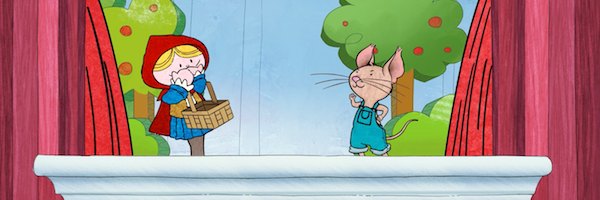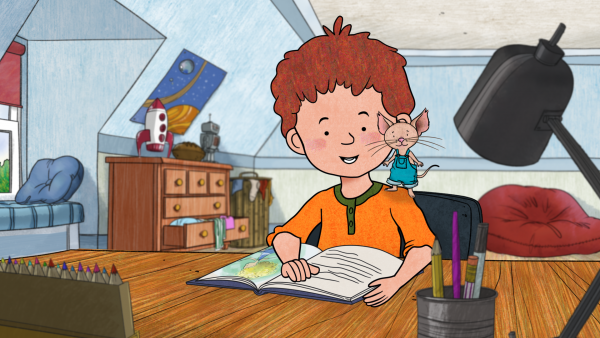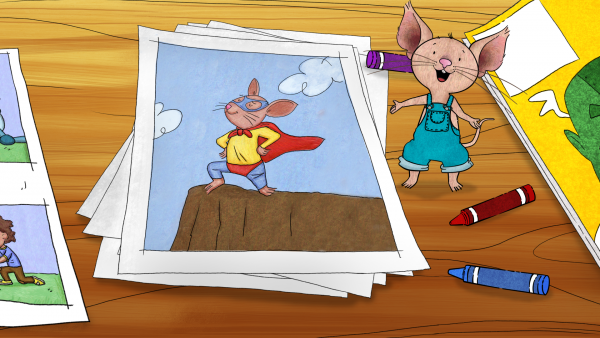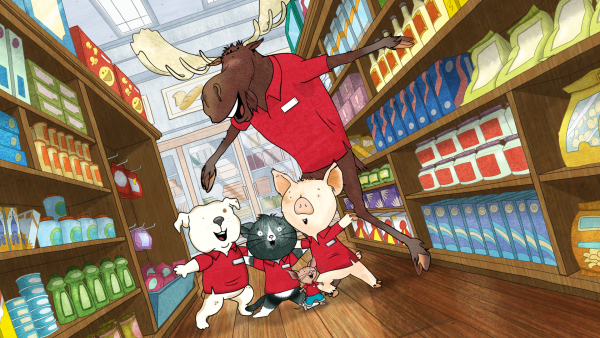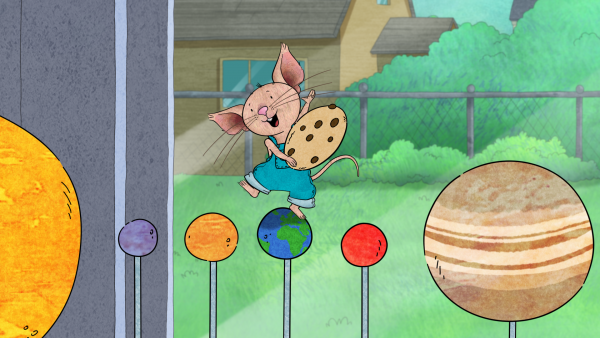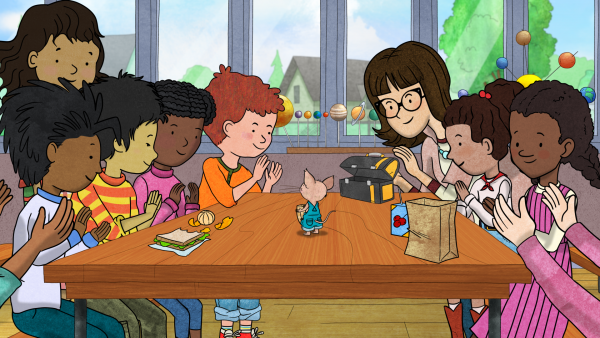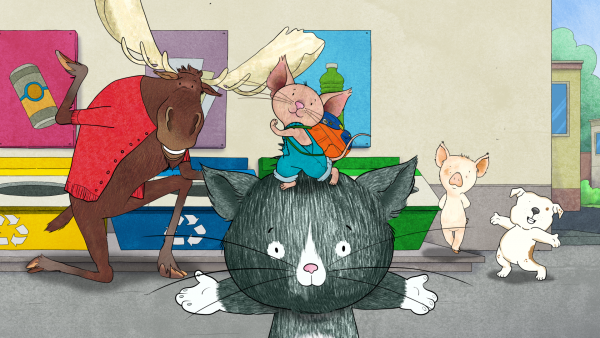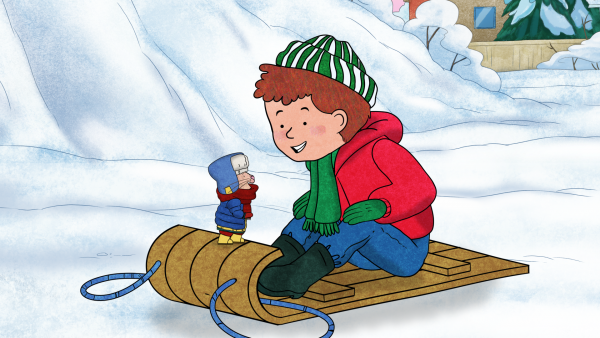If you're like me, when you hear the words If You Give a Mouse a Cookie, you're instantly transported back to your childhood as you remember your mom reading you the super-cute kids story written by Laura Numeroff and beautifully illustrated by Felicia Bond. Great reads in and of themselves, each story was actually a mini-logic lesson in disguise, a circular tale that included an "if/then" premise as its main plot point. The classic children's stories are now part of the warm-and-fuzzy nostalgia feels for a whole new generation of storytellers and bedtime listeners alike, but there's an all-new version of the tale that's coming to Amazon.
Starting November 7th, 26 stories from the world of If You Give a Mouse a Cookie will be available to stream over Amazon Prime Video. In advance of the series' debut, I had a chance to talk to the show's writer Ken Scarborough all about what happens when you give a mouse a cookie, give a dog a doughnut, or give a pig a pancake. We chatted about his previous efforts writing in this world for both the 2015 pilot episode and the 2016 Christmas special, which led to the green light for the brand new series. The former Doug writer also shared his insight on whether or not that particular Nicktoon is getting a reboot.
But first, check out our exclusive clip from the upcoming series to get an idea of what If You Give a Mouse a Cookie will look and sound like:
How did this project come about?
Ken Scarborough: They called me in 2013. A few different people gave pitches, but they liked my take on it. The pilot went on two years ago in November of 2015, and people could vote on various pilots that went up, so two years later, we have the first 13 all done at once and we’re going to get them out there. I think they called me because I did Arthur, based on the book, so I get a lot of calls that are book-based. I did Martha Speaks and then I came in as head writer on Curious George, so I’ve sort of become associated with taking books and turning them into kids’ series. Everybody has a slot, and I guess that’s my slot!
How did the pitch evolve over the course of the series' timeline?
Scarborough: They came and wanted an overall series pitch: How would I do it and what appealed to me? Who had a sense of the book that they liked? And I liked that it had a sense of circularity; it all comes back to where it started. It’s like, “Read it again, mom!” It’s perfect as a book, but the trick is, how do you turn that into a TV series? The mouse doesn’t really speak in there, nobody has any names … you kind of see the characters expressed—like the moose likes to knit, and little things like that—but in the development of this series, the pitch was about what was important and what values we wanted to get across. That’s what’s most important to me: You take these things and turn them into characters, then each of them represent a different world-view and you get a clash of personalities. They still know how to work it out, but everybody has their own way of doing things, they still respect each other at the end, they still get along. I wanted the story to not just be meaningful to kids because our little guy gets stuff done and he’s pure exuberance, but also because it has something to say.
So the initial challenge of my pitch was to figure out who all these characters were. There are five kids and five animals from the five books—Moose/Muffin, Cat/Cupcake, Pig/Pancake, Dog/Donut—healthy choices! In the books, it’s in the illustrations more than anything that the animals sort of run the kids ragged; they’re the children of the kids and are sort of dragging them into adventures. All of that is in the vision of what I thought the show would be. That was refined in terms of storytelling things like: What’s the family like? Do you see the parents? Just a million little decisions that, once you see it on the air, you realize it’s meant to be that way.
On collaborating with Amazon:
Scarborough: They’re very hands-on; there’s a lot of back-and-forth with Amazon. Education for Amazon is very much the idea of potential and possibility for the kids, that every moment is a choice, an if/then thought process and association of ideas: “If I do this, then I’m going to want that.”
What sort of structure can we expect from these 26 new stories?
Scarborough: In a larger sense, the half-hours coming out are interesting: Both segments start with the same item, with Mouse asking for a cookie, or a shoe, one item. Then, it goes in two different directions. So you can start by asking for a crayon, or a sock, or a stick, and two different stories would come out from that, in some sense. In one, Mouse uses the sock as a sleeping bag, so the story becomes about a backyard campout. And then in the other one, he finds a lucky sock to bring to the kids. So the idea is that not only is every moment a choice for kids, but in a larger sense, things could go either direction; you can start out by asking for a pancake and take two crazy, different paths that develop.
They’re all 11 minutes. They’re all kept as pairs as if it were a half-hour TV show; they’re packaged that way. Because of the educational ideas of theirs, they wanted to keep it as a half-hour where they would have these paired-up episodes. It’s murderous to try to figure out how a character can ask for something four times an episode, at the beginning and at the end, and then in the second story. Hopefully it’s a bit surprising and the story ends up in a place you didn’t expect in the beginning, but also has a feeling of coming home. I always liked that the stories are about going out and coming back home to the same place and the same person. That becomes a bit of a challenge. Hopefully it seems pretty seamless when it comes out.
Are they original stories or tales pulled from the books themselves?
Scarborough: We started with a lot of the same objects, but … these are 22-page books, presumably, and we’re doing a round of 26 stories, and you’re telling dramatic stories, so you want a little bit more of a goal and to know whether you’re getting closer or further away from it. Part of it was figuring out the structure of these things so that they have that sort of “What’s next?” feeling and that of [Mouse] getting closer to where he wants to be. That was the trick, to play off the unexpectedness of what Mouse wants; you think he’s going to go left and he goes right, and you get the comedy that comes out of that. We sort of start with the stories, but in every case we gave it more of a story arc.
What has it been like to work with the new and returning cast members?
Scarborough: The voices cast were great. The kids are actual kids, and all the animals are voiced by adults, with a little broader comic possibilities for them. Mouse and Moose are the same actor, which is fun to hear him switching back and forth sometimes. The cast is great. Jeff Bennett, I love Jessica [DiCicco], they’re just really hilarious. They can take a line that seems a little flat on the page and are just able to infuse it with so much character and stuff. It’s a delight.
The cast is the same, the voices will all sound the same. Same animators and animation studio, same gang over at Amazon. It’s pretty consistent. The fun thing is that each of the animals have an episode where Mouse is not the lead. The kids are great, too. They bring a real sweetness and a reality to them. The director’s great, too, she’s kind of no-nonsense.
The animation style seen so far is very similar to Bond's illustrations. What was that conversation like?
Scarborough: I think they really strived to make it look like the book. For me, I thought that world looked a bit rural in the books. But when I come into these things, I think about how close they are to each other, how they get from one house to the other. Do they have to cross the street? Can all the things be connected in the back to a park so they can all go out and play without having to go out into the street and cross roads? But to have that bucolic kind of thing where we can go on a boat, or go down the river, or go play whatever sport we wanted to play. When I was a kid, the ability to go out and play was so important, and at the same time, to have that protected area as part of the design. The town is also built on a hill because you want crazy things to happen, like Mouse having a runaway cart. So my design contribution is, what’s the story going to be and how are they going to get from one place to another? It’s neat, they kept both the sense of the small town and the rural thing with houses that have nothing else behind them. It’s neat to see these worlds evolve.
Half the comedy in those books comes from pictures. Felicia [Bond] did an amazing job at giving them a comic sense and getting her vision across for the story.
Finally, don't get your hopes up about a potential Doug reboot, despite Hey Arnold! and Rocko's Modern Life getting new installments:
Scarborough: I haven’t [heard anything], but God knows they could be talking to Jim [Jinkins]. I think he’s always wanted to bring it back. That’s really his heart and soul. I have no idea how that show plays … I don’t really know much about the business of it, but that’s interesting that they’re bringing those back. But that’s super-fun and kinda neat. I think so many people have fond memories of that era and of those cartoons; they kind of changed the world.
Be sure to check out Amazon starting November 7th for If You Give a Mouse a Cookie!

